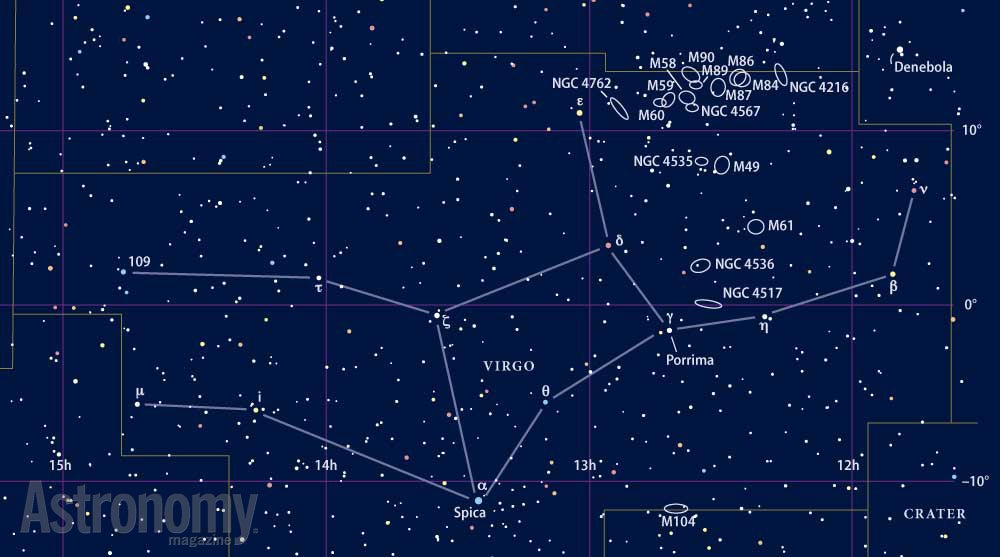
Expand your observing at Astronomy.com
StarDome
Check out Astronomy.com’s interactive StarDome to see an accurate map of your sky. This tool will help you locate this week’s targets.
The Sky this Week
Get a daily digest of celestial events coming soon to a sky near you.
Observing Talk
After you listen to the podcast and try to find the objects, be sure to share your observing experience with us by leaving a comment at the blog or in the Reader Forums.
Brilliant twins
This week’s small-telescope target is a pair of bright double stars in the constellation Crux the Southern Cross. The first is Acrux (Alpha [α] Crucis).
Because these stars have a separation of 4″, any size telescope will split Acrux. But don’t shelve your big scope just yet. This luminary makes a startlingly beautiful double star split at high power through an 8-inch or larger telescope.
The primary shines at magnitude 1.4, and the secondary is only half a magnitude fainter, at 1.9. Both stars are blue, albeit you should notice ever-so-slightly different shades.
Your second target in the constellation is Gacrux (Gamma [γ] Crucis). This is the one of the easiest binaries in the sky to find and to split.
The orange primary is a brilliant red giant star that shines at magnitude 1.6. Even at your scope’s lowest power, you’ll spot the blue secondary nearly 2′ — exactly 111″ — to the north-northeast. It shines at magnitude 6.4.Lost and found
This week’s first large-scope object is the Lost Galaxy, also known as McLeish’s Object and NGC 4535. This magnitude 10.0 barred spiral floats in the constellation Virgo the Maiden. It measures 7.0′ by 6.4′. You’ll find it 2.8° southwest of magnitude 4.9 Rho (ρ) Virginis.
This is a little-known target that becomes a showpiece through large amateur telescopes. NGC 4535 has a large, bright central region. This area looks rectangular because of the bar. Closer examination at magnifications above 300x reveals two faint spiral arms that emanate from this central region. Oh, and one note: The 13th-magnitude star enmeshed in the northern spiral arm is not a supernova.
Robert Burnham Jr., writing in his Celestial Handbook, said that early-20th-century American amateur astronomer Leland S. Copeland called NGC 4535 the Lost Galaxy “from its hazy phantom-like appearance in the amateur telescope.”
McLeish’s Object was a name given in honor of astronomer David McLeish, who made a number of discoveries at Cordoba Observatory in Argentina. And, just so you don’t get confused, please note that McLeish’s Interacting Object is a completely different galaxy. McLeish discovered that object, now cataloged as IRAS 20048-6621, in 1948.That’s a lot of galaxies
This week’s second large-telescope target is Abell 1367, a galaxy cluster usually called the Leo cluster.
This vast group sits mainly to the southwest of the magnitude 4.5 star 93 Leonis, although it extends a bit north and east of that star as well. Surveys have identified 542 galaxies within 1° of the cluster’s center, and 1,682 within 2°.
Abell 1367 sprawls over a region nearly 2.5° in diameter. It lies 330 million light-years away. At this distance, the galaxies’ light appears faint, but a couple dozen members are bright enough to earn NGC designations.
For example, the centrally placed, nearly 1′ glow of magnitude 11.8 NGC 3842 shows up nicely through an 8-inch telescope at a dark site. Others include magnitude 12.7 NGC 3861, magnitude 12.7 NGC 3862, magnitude 13.3 NGC 3837, and magnitude 13.7 NGC 3840.
Upgrade to a 14-inch scope, insert an eyepiece that magnifies 300x, and scan the region, and you’ll view 50 tiny galaxies. I’ve observed this cluster through a 30-inch reflector at a true-dark site. I can say honestly that, had I not stopped myself, I could have spent the entire night viewing Abell 1367. Sounds like a great future observing project for me or you.Each week, Astronomy magazine Senior Editor Michael E. Bakich, a master at explaining how to observe, posts a podcast about three or more objects or events you can see in the sky.
Targets for May 10–17, 2012
Small telescope: Two double stars in Crux
Large telescope: The Lost Galaxy (NGC 4535)
Large telescope: The Leo cluster









